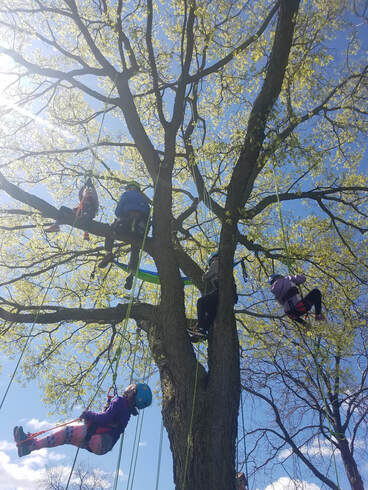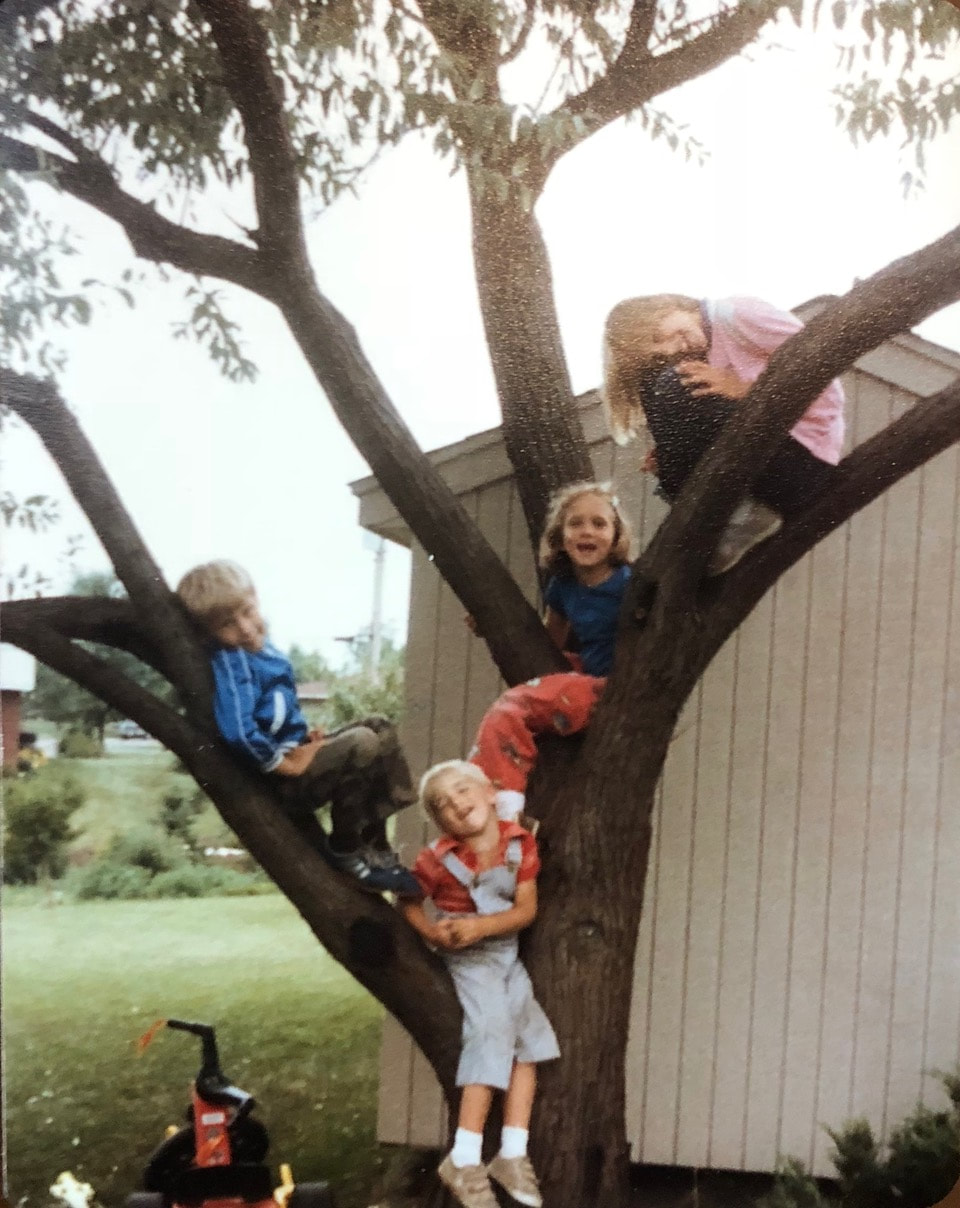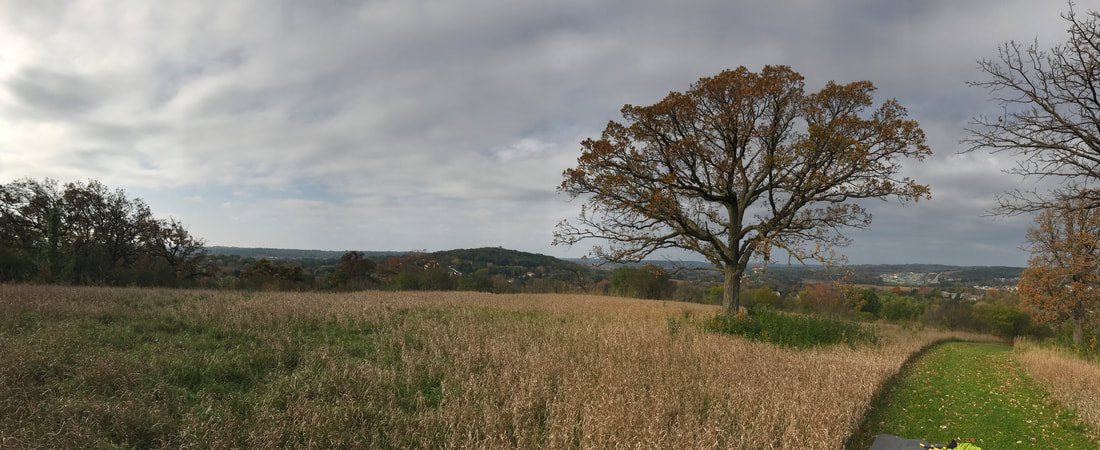|
I spend time with trees by sitting beneath them or hiking through the forest. Of course, I also like to climb them. I’ve enjoyed climbing trees for as long as I can remember. The oak in our front yard in Miami was one of my favorite climbing trees growing up. It was a rite of passage when I could finally jump high enough to grab hold of the lowest limb and pull myself into the tree without any assistance from my older brothers or standing on my bike. “I used to climb trees.” I hear this quite often when I tell people what I do. After sharing enjoyable memories, some people follow up with, “it was so much fun.” Therefore, it begs the question, “Why did you stop?”
When most people think of tree climbing, they tend to envision free-climbing, using hands and feet to climb branches without the aid or safety of rope. Technical tree climbing utilizes ropes and saddles to climb trees. Each style of climbing offers a variety of benefits and experiences for the climber. Free Climbing Growing up in Puerto Rico and Florida, we climbed numerous rubber trees (Ficus elastica). Our hands coated in sticky sap enabled us grip and swing from their aerial roots like Tarzan! We could shinny up the schefflera trees and climb onto the roof of our house. We climbed and picked countless mangos, loquats and tangerines from trees around the neighborhood, bringing them home to feast upon them at the top of our favorite climbing tree. Those days of free-climbing involved smaller and even some medium sized trees. For the most part, climbing a tree in this manner requires that the tree have enough branches to provide hand and footholds. Free-climbing small trees calls upon our primal instincts as we explore these living jungle gyms. Free-climbing a tree without the use of rope, you are exposed to a higher risk of falling. I think this is the primary reason people are discouraged or even forbidden to climb trees, even though playgrounds are filled with structures for climbing and enabling children to get off the ground. The simple act of climbing develops a person’s hand-eye coordination and motor skills. Each step of the way while tree climbing, you are determining where to place your hands and feet to gain vertical height. Trees do not have a standard arrangement of limbs or spacing between branches like a fabricated jungle gym. Planning a few steps ahead is a necessity as the path is not a straight line up. Returning to the ground can be even more challenging. An adrenaline rush and flood of emotions accompanies this type of play. During our time in the tree, we are also rewarded with releases of “feel good” hormones like endorphins, dopamine and serotonin. You don’t need to know what these are because you can feel their effects even if you don’t know their names. I love reading the research about such benefits today as that helps fuel my passion for providing an incredible experience for people to spend time in the trees. Back then, all I cared about was that climbing trees was a fun and exciting way to spend my day.  Technical Tree Climbing When we moved to St. Louis, we had a sugar maple that could be climbed, but it wasn’t nearly as much fun as my previous climbing tree. Aside from the maple, we had oaks, hickories, and elms that were too tall to climb since the lowest branches were about 20’ high. If you have the desire to climb into taller, larger, older trees, you are out of luck if they do not have low and small enough branches for climbing. Thankfully, ropes, saddles and specialized techniques allow us to climb into these magnificent trees. Climbing rope requires a unique set of motor skills and spatial awareness in addition to those skills we developed as free-climbers. It also requires the use of muscles you may not have known were there! Sitting back in your saddle and letting the tree and rope support your weight has an energizing effect. Once you climb into the crown of the tree and can play in the branches, you are continuously transferring your weight and sense of security between sitting in rope and being supported by a branch. The transition back and forth brings new challenges. This is part of what makes technical tree climbing a lot of fun and different from free-climbing. Once you begin to master the balance between using branches and using rope, you are better able to climb and explore the tree at will. You are able to enjoy the freedom of spending time in the branches without having to hold on. Another key difference is that, with rope, you can climb much higher. Some of the taller trees in Wisconsin allow us to ascend over 100 feet above the ground. The tallest trees in the world allow climbers to reach heights over 350 feet. While these heights sound impressive, the reality is that most people are challenged and impacted by reaching heights between 10 and 35 feet. The trees we climb around Wisconsin are perfect as they allow us to play in this realm. For those who like pushing the limits, I often include a few ropes that reach 40-50 feet during my climbs. In private excursions and guided climbs, we go even higher. In the end, the height each of us is most comfortable at will vary greatly. Using rope and saddle enables you to progressively challenge yourself to reaching new heights. Climb Trees
As a kid, I free-climbed trees because I didn’t know any other way. These days I climb using rope and saddle. Thanks to this hobby, I am able to explore amazing trees and chase views that few people will ever get to enjoy. I doubt my parents ever stopped to ponder the emotional and cognitive benefits I was receiving during my time in the trees. They knew it was important for kids to play outside because they could see the differences in my demeanor between those days and the ones I spent mostly inside in front of the tv and playing video games. Today, I notice differences in myself during and following my time in the trees. When I reflect back on my childhood, I am grateful my parents allowed me to climb trees. As long as you take into consideration that the tree you are climbing is a living being and do what you can to minimize your impact on the tree, I encourage you to get out and enjoy the trees. Take your children and loved ones with you. *Fine print: prior to entering a tree, I perform a thorough inspection to assess its health and structural integrity. There are a number of issues and conditions that can make a tree unfit for climbing. If you are unsure of the condition of your trees, please contact an ISA Certified Arborist and have them assess your tree (yes, even the small ones). If you are interested in climbing tall and mature trees, give me a call!
2 Comments
9/2/2021 03:19:07 pm
I'm 68 years old and over the past two years have been developing my free climbing trees. yesterday I climbed an American Beech climbing up 45-50 feet 40 times as I am training for a charity event in October where I will be climbing 100 trees during one day. yesterday's climbs took me just under four hours. You can see a time-lapse video of my climb and would love to hear back from you. you can see my interest on social media at https://www.youtube.com/watch?v=4JUiL_bbLzw
Reply
4/11/2022 08:33:21 pm
An arborist is a specialist in the art and science of caring for individual trees.
Reply
Leave a Reply. |
AuthorAs a G.O.T.C. Recognized Master Instructor & Facilitator, I.S.A. Board Certified Master Arborist, and T.C.I.A. Certified Treecare Safety Professional, Curt has spent over 30 years dedicated to the study and care of trees. Categories
All
Archives
May 2024
|
|



 RSS Feed
RSS Feed
